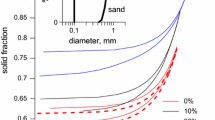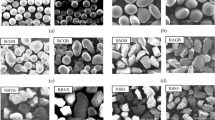Abstract
Resonant column experiments were conducted with an extremely fine-grained material, viz. an α-aluminum oxide (Al2O3), which serves as a model material for cohesive soils with particle diameters in the range of μm. With this particle size interparticle forces from van der Waals and Coulombic interaction have an influence on the behavior of the material in dynamic shear tests. By adjusting the surface charge, and hence the Coulombic repulsion, we obtain repulsive or attractive particles, which influences sample fabric and shear stiffness. From the increase of shear stiffness at small strain (γ≤10−6) with effective pressure we have estimated the net interparticle pressure from surface forces in the range of some kPa for a mean particle diameter of 0.8 μm. Our results show that the behavior of fine-grained granular materials at small shear strains cannot only be described by their density and stress state. Particle surface forces have to be taken into account.
Similar content being viewed by others
References
S. S. Afifi & R. D. Woods, Long-Term Pressure Effects on Shear Modulus of Soils, J. Soil Mechanics and Foundations Division 97 (1971), p. 1445–1460
J. D. Bass, Elasticity of Minerals, Glasses, and Melts. In: Ahrens, T. J. (ed): Handbook of Physical Constants, (American Geophysical Union, Washington, DC, 1995), p. 45–63
L. Bergström, Hamaker Constants of Inorganic Materials, Adv. Colloid and Interface Sci. 70 (1997), p. 125–169
B. V. Derjaguin & L. Landau, Theory of the Stability of Strongly Charged Lyophobic Sols and the Adhesion of Strongly Charged Particles in Solutions of Electrolytes, Acta Physicochimica 14 (USSR) (1941), p. 633–662
G. Gudehus & M. Külzer, Einfluss von Ionen und Glasblasen auf die Kollapsneigung feinstkörniger Böden, Geotechnik 25 (2002), p. 12–19
B. O. Hardin & F. E. Richart, Jr., Elastic Wave Velocities in Granular Soils, J. Soil Mechanics and Foundations Division ASCE 89 (1963), p. 33–65
B. O. Hardin & V. P. Drnevich, Shear Modulus and Damping in Soils: Design Equations and Curves, J. Soil Mechanics and Foundations Division 98 (1972), p. 667–692
I. Ishibashi & X. Zhang, Unified Dynamic Shear Moduli and Damping Ratios of Sand and Clay, Soils and Foundations 33 (1993), p. 182–191
J. Israelachvili, Intermolecular and Surface Forces (Academic Press, London, 1992)
R. D. Mindlin, Compliance of Elastic Bodies in Contact, J. Appl. Mechanics 71 (1949), p. 259–268
M. Pourbaix, Atlas of Electrochemical Equilibria in Aqueous Solutions (Pergamon Press, Oxford, 1966)
B. Prange, Der Resonant-Column-Versuch: Theorie und Experiment. In: Symposium Messtechnik der DGEG München, 1983, p. 99–104
W. Stumm, Chemistry of the Solid-Water Interface, (New York: John Wiley & Sons, 2nd edition, 1992)
K. Terzaghi, Erdbaumechanik auf bodenphysikalischer Grundlage (Deuticke, Leipzig and Vienna, 1925)
C. Thornton & G. Sun, Axisymmetric compression of 3D polydisperse systems of spheres. In: Thornton, C. (ed): Powders and Grains (Balkema, Rotterdam, 1993), p. 129–134
C. Thornton, Numerical Simulations of Deviatoric Shear Deformation of Granular Media, Géotechnique 50 (2000), p. 43–53
E. J. W. Verwey & J. T. G. Overbeek, Theory of the Stability of Lyophobic Colloids (Elsevier, Amsterdam, 1948)
M. Vucetic & R. Dobry, Effect of Soil Plasticity on Cyclic Response, J. Geotechnical Engineering 117 (1991), p. 89–107
Author information
Authors and Affiliations
Corresponding author
Additional information
The study described in this paper was sponsored by the German Research Council (DFG), Research Group FOR 371-2. The support is gratefully appreciated.
We would like to thank Professor Gudehus for his valuable advice and many stimulating discussions.
The KSEM micrograph and the grain size distribution data have been provided by the Institute of Ceramics in Mechanical Engineering, University of Karlsruhe (Research Group FOR 371, German Research Council, DFG). We would like to thank for cooperation and support.
We thank the Institute for Technical Chemistry, Research Center Karlsruhe for providing the ESEM micrograph.
Rights and permissions
About this article
Cite this article
Richter, S., Huber, G. Resonant column experiments with fine-grained model material – evidence of particle surface forces. GM 5, 121–128 (2003). https://doi.org/10.1007/s10035-003-0144-8
Received:
Issue Date:
DOI: https://doi.org/10.1007/s10035-003-0144-8




